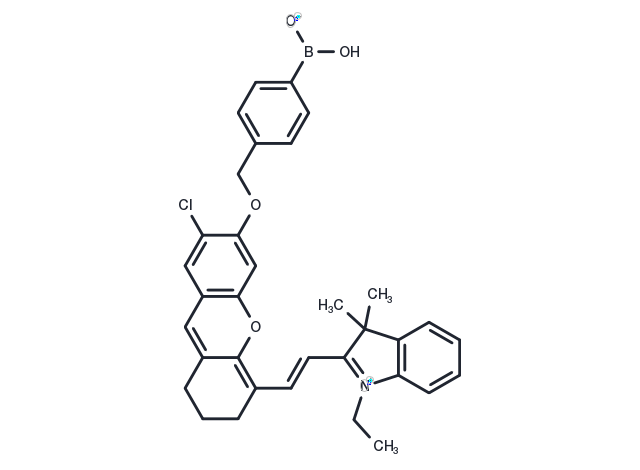keep away from direct sunlight
Powder: -20°C for 3 years | In solvent: -80°C for 1 year

NIR-H2O2 is a cell-permeable near-infrared (NIR) fluorescent turn-on sensor. It responds to H2O2 with a large turn-on NIR fluorescence signal upon excitation in the NIR region.

| Pack Size | Availability | Price/USD | Quantity |
|---|---|---|---|
| 100 mg | Inquiry | Inquiry | |
| 500 mg | Inquiry | Inquiry |
| Description | NIR-H2O2 is a cell-permeable near-infrared (NIR) fluorescent turn-on sensor. It responds to H2O2 with a large turn-on NIR fluorescence signal upon excitation in the NIR region. |
| In vitro | NIR-H2O2 is highly selective to H2O2 over other typical ROS and bio relevant species. HeLa cells incubated with NIR-H2O2 (5 μM) for 30 min at 37 °C provide almost no fluorescence. However, when the living HeLa cells loaded with NIR-H2O2 are further treated with H2O2, they give strong fluorescence. When stimulated by phorbol myristate acetate (PMA), macrophage cells may produce endogenous H2O2. The living RAW264.7 macrophage cells loaded with only the NIR sensor NIR-H2O2 (1 μM) display almost no fluorescence. However, the macrophage cells coincubated with PMA (3.0 μg/mL), and the sensor NIR-H2O2 (1 μM) exhibit a dramatic enhancement in the red emission. NIR-H2O2 is capable of fluorescent imaging of endogenously produced H2O2 in the living RAW264.7 macrophage cells. |
| In vivo | In an acute inflammation model induced by lipopolysaccharide (LPS), in vivo hydrogen peroxide (H2O2) production was generated by activated macrophages and neutrophils. Mice treated with both LPS and near-infrared-responsive H2O2 (NIR-H2O2) displayed significantly higher fluorescence readouts than those untreated or treated solely with NIR-H2O2. Specifically, fluorescence intensity in mice administrated with LPS and NIR-H2O2 was approximately 10- and 20-fold greater compared to mice treated with saline and the sensor, and mice treated with saline alone, respectively. |
| Molecular Weight | 565.89 |
| Formula | C34H33BClNO4 |
| CAS No. | T19038 |
keep away from direct sunlight
Powder: -20°C for 3 years | In solvent: -80°C for 1 year
You can also refer to dose conversion for different animals. More
bottom
Please see Inhibitor Handling Instructions for more frequently ask questions. Topics include: how to prepare stock solutions, how to store products, and cautions on cell-based assays & animal experiments, etc.
NIR-H2O2 T19038 Others NIR H2O2 NIRH2O2 NIR-H-2O2 inhibitor inhibit
